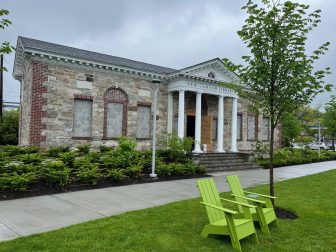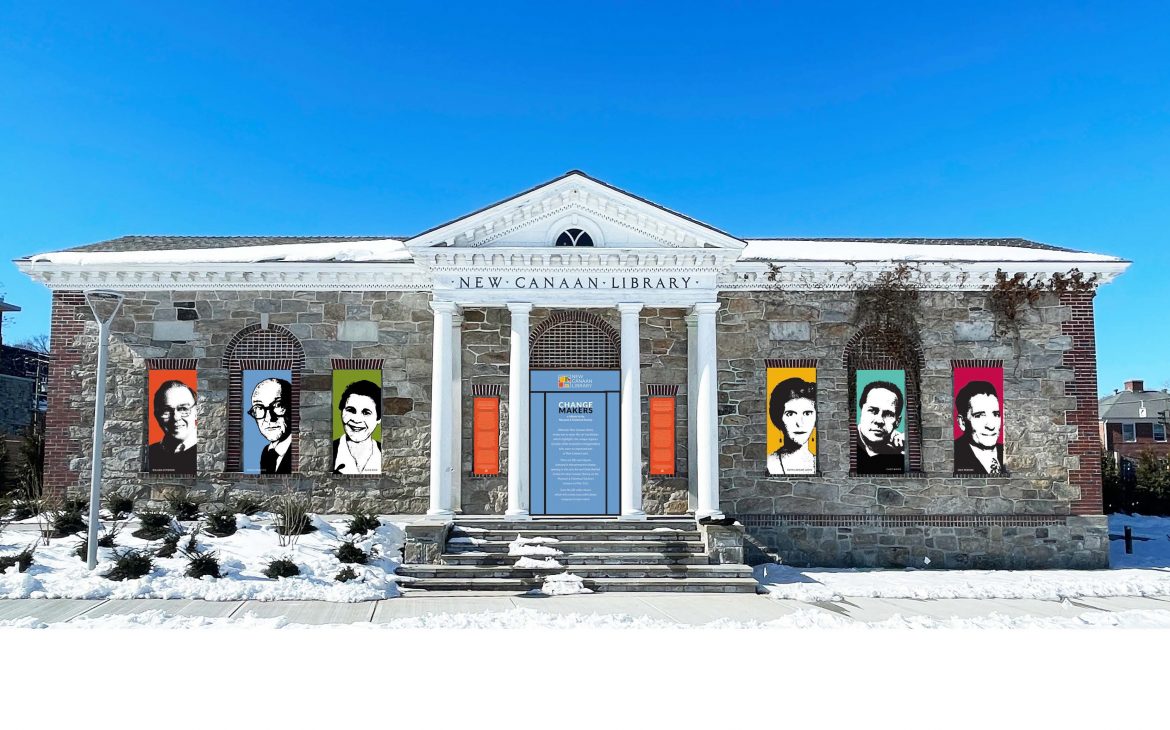As New Canaan Library prepares to take on the final phase of its remade campus—identifying a function for the 1913 building—it is also using the historic structure for a new art installation.

New Canaan Library’s 1913 building on May 15, 2024. Credit: Michael Dinan
And it’s partnering with one of the town’s most important local nonprofit organizations to do it: The New Canaan Museum & Historical Society.
NCM&HS this month is launching the new Jim and Dede Bartlett Center for New Canaan History. It’s built around a theme of “Making a Difference”—the people, businesses, and events that have shaped the community. As part of the permanent exhibition, the Museum has an interactive console of 50 New Canaan residents who had a significant impact on the town. Officials from the library looked at the images and biographies and selected six to feature in the windows of the legacy building.
“The New Canaan Museum was happy to be the library’s partner in celebrating the lives of transformative New Canaan residents,” said Nancy Geary, executive director of NCM&HS. “What better place to showcase six of its changemakers than in the windows of the legacy building from 1913?”
Ellen Crovatto, the library’s vice president of external affairs and philanthropy, said that although the 1913 has no functional use yet, “we were hoping that we could really make it feel like a part of the library and its mission and be part of the green and maybe actually make it look a little bit prettier than it currently looks.”
“And I was tasked to see what we can do to make it work,” she continued. “And I thought to myself, OK, we’ve got this incredible new center for history happening over at the Museum & Historical Society. And as the [1913] building was our co-home with the Historical Society right at the beginning, for many years, we have an origin story together. The Historical Society and the library were joined. We were together in that building. In fact, the original Salant Room was their space. And so I thought, wouldn’t it be fun to take the opportunity to demonstrate the links between us as organizations and to surface the fact that both of our organizations have a shared mission in terms of community service, lifelong learning and to do something that really helps to celebrate what they’re doing. I came up with the idea of a ‘Changemakers’ exhibit. It’s an art installation, which will be temporary.”
The library selected the following six influential residents for the Changemakers installation (bio snippets by NCM&HS):
- William Attwood: Born in Paris, William Attwood (1919-1989) grew up in New Canaan and studied history and politics at Princeton University. With the outbreak of World War II, he enlisted and worked in foreign intelligence. After the war, he stayed in Europe as editor of the Herald Tribune. Returning to the U.S., he was a speechwriter for President John Kennedy, an author and award-winning journalist, editor of foreign affairs for Look Magazine, editor in chief of Cowles Communication, and President of Newsday. He served as Ambassador to Guinea and then Kenya. A member of New Canaan’s Town Council, he founded the New Canaan Coalition for Nuclear Arms Control.
- Alice King: Born in New York City, Alice Darracott Seabrook (1890-1979) moved to New Canaan after her 1911 marriage to Clarence King, a professor at Columbia University. They lived on a 30-acre property in Silvermine where they welcomed minorities and refugees who could not find housing. She was an actress, singer, poet, and novelist, served on the Board of Public Welfare, and was active in the National Association for the Advancement of Colored People (NAACP). Realizing that Black people could not secure bank mortgages to purchase property, in 1941 she refurbished 12 houses on East Avenue and Cherry Street and first rented and then sold the homes to Black families, primarily parishioners from the Community Baptist Church.
- Philip Johnson: Philip Johnson (1906-2005) was best known for his modern and postmodern architecture. Along with several of his Harvard colleagues who later became better known as The Harvard Five, , he made significant contributions to the Mid-Century Modern movement which was a significant source of inspiration for the New New Canaan library building. In 1949, he built The Glass House on Ponus Ridge Road in New Canaan, now a National Landmark, where he lived with his partner, David Whitney. The New Canaan library is proud to partner with The Glass House on a popular lecture series: The Glass House Presents, an ongoing series of live events that extends the site’s historic role as a gathering place for artists, architects, and other creative minds.
- Max Perkins: Maxwell Evarts Perkins (1884-1947) graduated from Harvard and was hired as a reporter for the New York Times. In 1910, he married the writer Louise Saunders and they had five children. In 1917, while a book manager for Scribner’s Publishing, he met F. Scott Fitzgerald, and worked with him for three years on “This Side of Paradise.” Released in 1920, it was an enormous success. Promoted to editor, Perkins led Scribner’s transition into publishing contemporary novelists including Ernest Hemingway, Thomas Wolfe, and Marjorie Kinnan Rawlings. After World War I ended, he moved to 63 Park Street in New Canaan, now listed on the National Register.
- Ruth Lapham Lloyd: The daughter of Lewis and Antoinette Lapham, Ruth (1896-1984) had seven children in two marriages, including son Christopher Lloyd, an award-winning actor. With her husband, attorney Samuel Lloyd, the family moved into Waveny mansion full-time in 1940, and she inherited the entire property in 1956. A patron of the arts, she was known as New Canaan’s guardian angel, who donated land for the high school, sold her property to the Town for a park at a generously low price, helped to fund the Lewis Lapham wing of the New Canaan Library, and supported the Historical Society. She also established an endowment at the Metropolitan Museum of Art in New York City, allowing it to stay open late one night per week.
- Eliot Noyes: Considered the father of industrial design, Eliot Noyes (1910-1977) was an architect who graduated from Harvard’s Graduate School of Design in 1932. He worked for his professors Walter Gropius and Marcel Breuer in Cambridge, and then served as the Director for Industrial Design at Metropolitan Museum of Art from 1939-1946. Hired by IBM, he designed the Selectric Typewriter in 1961, and many corporate buildings, including the IBM Aerospace Research Center in Los Angeles. He also redesigned Mobil gas stations and fuel pumps. Married to architect Mary Duncan Weed (1915-2010), he raised his family in New Canaan in a modernist home that is now on the Connecticut Register of Historic Places.
Referring to the synergy between the library and NCM&HS, Crovatto said, “The idea was to really lock arms and celebrate what they’re doing.”
She added, “And what we’ve done is create a QR code so that everybody can just whiz by, click the QR code, go straight into all of the descriptions and then do further research as they want about the people. And it’s also a way to celebrate the changemakers in town. And I think there’s an incredible metaphor here about the value of changemakers and the fact that maybe we’re a bit of changemakers ourselves and that there’s an opportunity to create new legacy through change.”
The installation, which will be in place soon, comes as the library and wider community celebrates the official launch of the library green.
“We had our very first big event out there [Tuesday] with the NEAD Dancers,” Crovatto said. “They set up their stage and they had a wonderful performance. And so it’s really coming into full flower, with Groove on the Green and Spring Edition, we’re really starting to activate the space. The community has been loving it. It’s been tremendous to have the outdoor furniture.”
Now the library is turning its attention toward the question of how to make best use of the 1913 building, she said.
“Our goal is to be very transparent and very inclusive in terms of thinking about its use,” she said. “And making sure that it’s obviously a library function, but something that the community can enjoy, as well. And so our goal is to try within the next year to make sure that we put in place an opportunity for people to voice their ideas and concerns and their interests, as well as putting together a team of people—leadership at the library and our Board—to just try to come up with something that makes sense.”
Identifying a use will mean weighing many criteria, she said.
“We’re going to have to staff it,” she said. “We’re going to have to figure out how we get it funded. And then as we seek to get it renovated, we’re going to have to figure out how we pay for that. But the first step is going to be deciding its use.”
The library plans to bring in community members so that there’s “good representation” prior to any decision.
“We want a lot of voices in the room,” Crovatto said.

Art in 1913… As an artist I always thought to myself the 1913 portion would be great as a link to the arts. In whatever form it takes.
Thank you for your excellent insight.
What a relief! What a great idea!! What an interesting and intelligent development for our “town green” … It would seem that our community is fostering a healthy cultural change, right before our very eyes. Once again, I’m in awe of our library, and her passionate staff; to facilitate this project of “many voices” through the 1913 library space is nothing short of visionary. Thank you for this commitment to the arts, Artists and social change.
This is fabulous! What an innovative and interesting use of the space. I can’t wait to visit.
Like the old saying goes…Got a lemon, make lemonade. Clearly a very nice upgrade to the current cinder block windows.